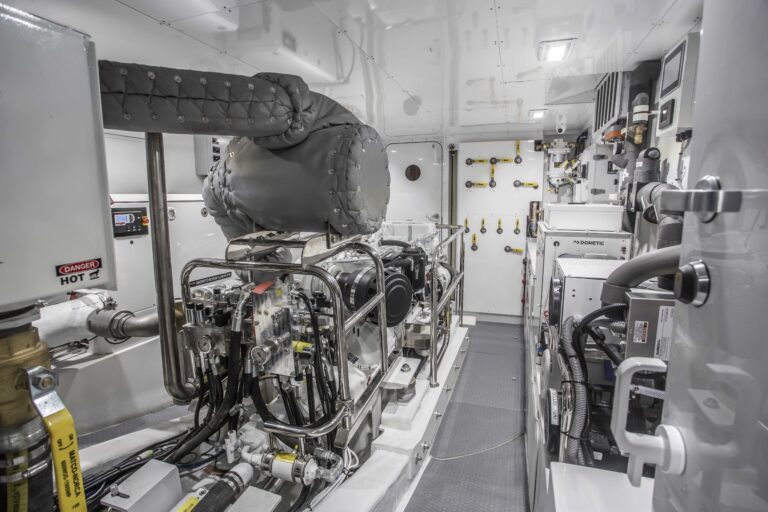
A clean bilge may not be as sexy as freshly varnished mahogany trim or oiled teak decks, but having one is an important part of keeping any vessel shipshape.
One popular (and ineffective) technique for cleaning a bilge is to flood it with a sudsy wash. This approach will never clean thoroughly enough to remove the stench from the sour water that the bilge pump leaves behind. In fact, doing this can make matters worse, especially if there is fuel or lube oil residue in the mix. Adding more water lets the residue spread over and cover additional bilge surface areas. I’ll use a commercial bilge cleaner, but only after I have sufficiently hand-scrubbed the bilge to remove as much grime and oil as possible.
Heat, moisture and a lack of constant fresh airflow all contribute to the nasty playground for unusual and long-lasting stinks. The key to a clean bilge is a dry bilge, and an easy way to achieve it is by using a wet vacuum to remove any standing water before you start a thorough sprucing up. Fix any areas where water can enter the bilge, such as hullside air-box drains, an ailing stuffing box or rudder post, a leaky hose or fitting, deck and hull joints, clogged hatch drains or an overflowing shower sump. Also check for condensate drippings from refrigeration or air conditioning units. Any water that enters the bilge can breed smells and mildew.
Look for rust on clamps, engine mounts or other hardware as indications of moisture. Inspect longitudinal stringers and engine beds, and clean out limber holes that may trap water and block drainage. Sop up puddles or drips beneath the engine oil pan or transmission and fuel filters. Just a few ounces of fuel oil mixed with water can fumigate the bilge in one fell swoop, as well as expose you to a fine for the discharge of oil waste into the water if a bilge pump suddenly comes to life.

The next step is to clean every reachable surface from bow to stern, top to bottom. This means getting outboard, on top of, under or around the engine, crawling through the lazarette port to starboard, and poking your head in the anchor rode locker (an especially musty compartment, particularly if the nylon rode is stowed wet). This work is pure elbow grease, but a spray cleaner like Simple Green or 409 helps to loosen grime in a small area at a time.
Be thorough. “Spray, brush, wipe and dry” is the drill that works best. Short- and long-handle brushes, nylon scrub pads, dampened clean rags and paper towels are the tools you will need to remove salt, grease, belt dust, mildew and similar debris. Change rags frequently to avoid spreading the collected grime, and wear rubber gloves to protect against sharp tie-wrap edges, hose clamps or other protrusions. Be neat, and you will save yourself valuable time by not having to go back and do more cleanup.
Certain unchecked bilge odors can be difficult to contain. A friend of mine had a horrible odor filtering up and into his shower stall. He had removed the shower drain hose that entered the sump box, which meant that shower water was draining directly into the bilge instead of going overboard. Soap, water, hair, dirt and debris from those showering created a real witches’ brew that grew in the warm bilge water throughout the summer. (Why had he removed the hose? The sump pump had stopped working, and this was his solution.)
Further investigation revealed that the pump had stalled because of hair, the coagulation of soap and shampoo, and his lack of maintenance. I cleaned the sump box and pump, and reconnected the hose to the sump inlet. Then, I told him to pour a bottle of hydrogen peroxide down the shower drain once a week for the rest of the season, and let the liquid sit in the sump for a few hours each time to prevent future clogs, and to destroy bacteria. Another bottle of hydrogen peroxide poured into the bilge helps, too. But avoid straight bleach because it can react with certain plastics in the bilge and cause future problems.
No sooner was this situation corrected when he called about more bilge smells, only this time they were wafting up into the head. This fix required new sanitation hoses from the toilet to the holding tank in the bilge. Sanitation hoses do not last forever, and as they age, the odors permeate through the hoses, which need to be replaced. A trick that helps to check the condition of similar hoses is to drape the hose with a clean cloth and leave it in place for a while. Remove the cloth and give it a sniff. You will know right away if the hose needs replacement.
Marine heads that flush with raw water instead of the boat’s freshwater supply also can develop odors when flushed because of the marine organisms living in that water supply. New hoses will also solve that problem.
Not the worst, but the most memorable bilge odor I have encountered occurred on a boat with hatch drains that emptied into the bilge, and not through a typical network of hoses that carried the water overboard. The owner had caught several tuna and cleaned them on deck, rinsing the fish regularly with the boat’s saltwater wash-down pump. He called me that night and told me to stop by the boat the next day for some prime tuna, which he had packed into a big, ice-filled Igloo cooler and left on the deck.
When I arrived at the boat, a cloud of black flies was buzzing around the cockpit, and the owner was beside himself cursing and swatting. I went aboard and was nearly knocked out by a horrendous fog that became worse when I went into the cabin. I lifted a hatch in the salon sole, and the bilge was virtually flooded, almost to the floorboard, with a greasy soup of tuna blood and tuna parts that had seeped into the bilge via the deck’s open hatch drains.
I flipped the bilge pump switch, and the red water flowed overboard, but the flies and smell were relentless. It took many buckets of Dawn dish detergent to circulate sudsy water throughout the bilge and clean out the fish debris before we dried the space with a wet vacuum.

To this day, when I lift a hatch aboard any boat, I check to see where the hatch drains lead—every boat, every hatch, and I still hold my breath when I do it.
This tale brings me to a final point: Ventilation is critical to maintaining a dry bilge. After washing your boat, open a cockpit hatch to let fresh air circulate in the lazarette. Do the same with the access door or hatch to the engine room, and if you have a hatch over the anchor rode locker, lift that, too. Fresh air will flow deep inside the boat from stern to bow, and will do wonders for keeping your belowdecks equipment clean and dry.
I would also suggest copying my habit of placing a bucket near any open hatch, as a cautionary aid.











